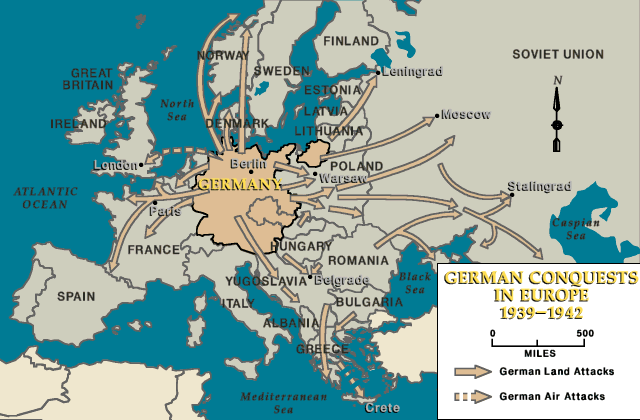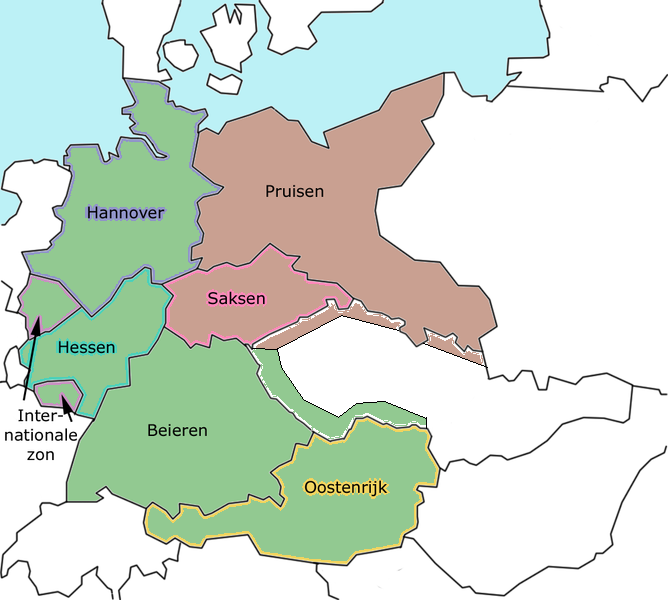Nazi Germany (German: Nazideutschland), also known as the Third Reich (German: Drittes Reich), but officially called German Reich (German: Deutsches Reich) from 1933 to 1943 and Greater German Reich (German: Großdeutsches Reich) from 26 June 1943 onward, is the name commonly used to refer to the state of Germany from 1933 to 1945, when it was a totalitarian dictatorship ruled by Adolf Hitler and his Nazi Party. Colloquially the state was also called Greater Germany (German: Großdeutschland) after 1938. Historiographically the period is generally referred to as die Zeit des Nationalsozialismus or NS-Zeit ("the National Socialist era") in Germany.

In World War II, Germany

Germany After World War II
On 30 January 1933, Adolf Hitler legally became Chancellor of Germany, appointed by President Paul von Hindenburg. Although he initially headed a coalition government, he quickly made Hindenburg a figurehead and eliminated his non-Nazi partners. The Nazi regime restored economic prosperity and ended mass unemployment using heavy military spending while suppressing labor unions and strikes. The return of prosperity gave the regime enormous popularity and made Hitler's rule mostly unchallenged, although resistance grew after the onset of military aggression, culminating in the failed 20 July plot in 1944. The Gestapo (secret state police) under Heinrich Himmler destroyed the liberal, Socialist and Communist opposition and persecuted the Jews, attempting to force them into exile while taking their property. The Party took control of the courts, local government, and all civic organizations except the Protestant and Catholic churches. All expressions of public opinion were controlled by Hitler's propaganda minister, Joseph Goebbels, who made effective use of film, mass rallies, and Hitler's skillful oratory.

This map does.
The Nazi state idolized Hitler as its Führer ("Leader"), centralizing all power in his hands. Nazi propaganda centered on Hitler and was quite effective in creating what historians call the "Hitler Myth" – that Hitler was all-wise and that any mistakes or failures by others would be corrected when brought to his attention. In reality, Hitler had a narrow range of interests and decision-making was diffused among overlapping, feuding power centers; on some issues he was passive, simply assenting to pressures from whoever had his ear. All top officials still reported to Hitler and followed his basic policies, but they had considerable autonomy on a daily basis.

World War II at Nuremberg,
Hitler's foreign policy during the 1930s used a diplomatic strategy of making seemingly reasonable demands, threatening war if they were not met. When opponents tried to appease him, he accepted the gains that were offered, then moved on to his next goal. That aggressive strategy worked as Germany pulled out of the League of Nations (1933), rejected the Versailles Treaty and began to re-arm (1935), won back the Saar (1935), remilitarized the Rhineland (1936), formed an alliance ("axis") with Benito Mussolini's Italy (1936), sent massive military aid to Francisco Franco in the Spanish Civil War (1936–39), annexed Austria in the Anschluss (1938), took over Czechoslovakia after the British and French appeasement of the Munich Agreement of 1938, formed a peace pact with the Soviet Union (Molotov-Ribbentrop Pact) in August 1939, and finally invaded Poland in September 1939. Britain and France declared war, resulting in the start of World War II - somewhat sooner than the Nazis had prepared for or expected.

World War Two - German

GERMANY AFTER WORLD WAR II
During the war, Germany conquered or controlled most of Europe and North Africa, intending to establish a "New Order" in Europe and elsewhere of complete Nazi German hegemony. The Nazis also persecuted and killed millions of Jews, Romani people and others in the Holocaust. Despite its Axis alliance with other nations, mainly Italy and Japan, by 8 May 1945 Germany had been defeated by the Allied Powers, and was occupied by the Soviet Union, the United States, Britain and France. Some 40 million Europeans may have died as a consequence of the war.

since World War II is

world war ii map

Germany lose World War II?
Hitler, the Nazis and their Holocaust became the symbol of evil in the modern world. Newman and Erber (2002) write, "The Nazis have become one of the most widely recognized images of modern evil. Throughout most of the world today, the concept of evil can readily be evoked by displaying almost any cue reminiscent of Nazism...."

Make My Post War Map Possible

Map 3 of Germany
The most popular name to refer to this state in English is Nazi Germany (German: Nazideutschland), mostly used to differentiate it from other historical German states such as Imperial Germany and Weimar Germany (although there is direct legal continuity between the Weimar and Nazi periods, see below). Third Reich (German: Drittes Reich) is another common but informal term, suggesting a historical succession from the medieval Holy Roman Empire (962–1806) and the modern German Empire (1871–1918). This term, although in common usage among many Germans at the time, eventually fell from favor with the Nazi authorities, who banned its continued use by the press in the summer of 1939. Germany had two official names during the Nazi period; German Reich (German: Deutsches Reich), which was in use from the Unification of Germany in 1871 onward until 1943, when the regime legally renamed it Greater German Reich (German: Großdeutsches Reich).

Widely used map of Germany and

German territories formed

World War II-era map of the

sites from World War II

World War II Headlines

In World War II, Germany

Germany After World War II
On 30 January 1933, Adolf Hitler legally became Chancellor of Germany, appointed by President Paul von Hindenburg. Although he initially headed a coalition government, he quickly made Hindenburg a figurehead and eliminated his non-Nazi partners. The Nazi regime restored economic prosperity and ended mass unemployment using heavy military spending while suppressing labor unions and strikes. The return of prosperity gave the regime enormous popularity and made Hitler's rule mostly unchallenged, although resistance grew after the onset of military aggression, culminating in the failed 20 July plot in 1944. The Gestapo (secret state police) under Heinrich Himmler destroyed the liberal, Socialist and Communist opposition and persecuted the Jews, attempting to force them into exile while taking their property. The Party took control of the courts, local government, and all civic organizations except the Protestant and Catholic churches. All expressions of public opinion were controlled by Hitler's propaganda minister, Joseph Goebbels, who made effective use of film, mass rallies, and Hitler's skillful oratory.

This map does.
The Nazi state idolized Hitler as its Führer ("Leader"), centralizing all power in his hands. Nazi propaganda centered on Hitler and was quite effective in creating what historians call the "Hitler Myth" – that Hitler was all-wise and that any mistakes or failures by others would be corrected when brought to his attention. In reality, Hitler had a narrow range of interests and decision-making was diffused among overlapping, feuding power centers; on some issues he was passive, simply assenting to pressures from whoever had his ear. All top officials still reported to Hitler and followed his basic policies, but they had considerable autonomy on a daily basis.

World War II at Nuremberg,
Hitler's foreign policy during the 1930s used a diplomatic strategy of making seemingly reasonable demands, threatening war if they were not met. When opponents tried to appease him, he accepted the gains that were offered, then moved on to his next goal. That aggressive strategy worked as Germany pulled out of the League of Nations (1933), rejected the Versailles Treaty and began to re-arm (1935), won back the Saar (1935), remilitarized the Rhineland (1936), formed an alliance ("axis") with Benito Mussolini's Italy (1936), sent massive military aid to Francisco Franco in the Spanish Civil War (1936–39), annexed Austria in the Anschluss (1938), took over Czechoslovakia after the British and French appeasement of the Munich Agreement of 1938, formed a peace pact with the Soviet Union (Molotov-Ribbentrop Pact) in August 1939, and finally invaded Poland in September 1939. Britain and France declared war, resulting in the start of World War II - somewhat sooner than the Nazis had prepared for or expected.

World War Two - German

GERMANY AFTER WORLD WAR II
During the war, Germany conquered or controlled most of Europe and North Africa, intending to establish a "New Order" in Europe and elsewhere of complete Nazi German hegemony. The Nazis also persecuted and killed millions of Jews, Romani people and others in the Holocaust. Despite its Axis alliance with other nations, mainly Italy and Japan, by 8 May 1945 Germany had been defeated by the Allied Powers, and was occupied by the Soviet Union, the United States, Britain and France. Some 40 million Europeans may have died as a consequence of the war.

since World War II is

world war ii map

Germany lose World War II?
Hitler, the Nazis and their Holocaust became the symbol of evil in the modern world. Newman and Erber (2002) write, "The Nazis have become one of the most widely recognized images of modern evil. Throughout most of the world today, the concept of evil can readily be evoked by displaying almost any cue reminiscent of Nazism...."

Make My Post War Map Possible
Map 3 of Germany
The most popular name to refer to this state in English is Nazi Germany (German: Nazideutschland), mostly used to differentiate it from other historical German states such as Imperial Germany and Weimar Germany (although there is direct legal continuity between the Weimar and Nazi periods, see below). Third Reich (German: Drittes Reich) is another common but informal term, suggesting a historical succession from the medieval Holy Roman Empire (962–1806) and the modern German Empire (1871–1918). This term, although in common usage among many Germans at the time, eventually fell from favor with the Nazi authorities, who banned its continued use by the press in the summer of 1939. Germany had two official names during the Nazi period; German Reich (German: Deutsches Reich), which was in use from the Unification of Germany in 1871 onward until 1943, when the regime legally renamed it Greater German Reich (German: Großdeutsches Reich).

Widely used map of Germany and

German territories formed

World War II-era map of the

sites from World War II

World War II Headlines
No comments:
Post a Comment